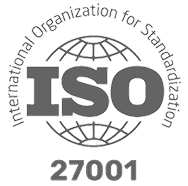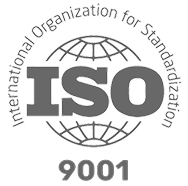Employee recognition is the act of acknowledging and rewarding employees for their contributions, performance, or behaviour at work. It can take many forms, from a simple thank-you to formal awards or incentive programs, and plays a key role in boosting morale, engagement, and retention.
Employee recognition at work plays a crucial role in fostering a positive work environment and motivating employees to perform at their best.
In this comprehensive guide, we will explore the significance of employee recognition, the various types of recognition programs, and how to create a functioning recognition culture in the workplace. Additionally, we will highlight the role of online employee engagement software in fostering a culture of employee recognition. Discover the ultimate guide to employee recognition today!
What is Employee Recognition?
The definition of employee recognition is as follows: employee recognition refers to the act of acknowledging and appreciating employees’ work, achievements, and contributions.
It involves providing positive feedback, rewards, and incentives to individuals or teams that have demonstrated exceptional performance or gone above and beyond their regular responsibilities. Recognising a good employee is about valuing their efforts and making them feel appreciated, which, in turn, boosts their morale and engagement.

Give Your Employees the Recognition and Motivation They Deserve
Does your team need a little extra motivation? Our platform provides powerful insights into your team’s performance and various recognition tools that help ensure everyone feels appreciated.
Why is Employee Recognition Important?
Employee recognition is crucial to creating a positive work culture and fostering employee engagement. It motivates employees, i.e. your internal customers, and boosts productivity. It also helps retain top talent and build loyalty within your organisation. Let’s now explore the importance of employee recognition and how it contributes to a thriving work environment.
1. Motivation and Productivity
Recognising employees for their hard work and achievements enhances staff motivation and encourages them to maintain high levels of productivity. When employees feel valued, they are more likely to go the extra mile and strive for excellence.

2. Retention and Loyalty
A culture of recognition at work fosters a sense of loyalty among employees. Recognised employees are more likely to stay with an organisation, reducing employee turnover rates and associated costs. They also become advocates for the company, attracting top talent and enhancing the employer brand.
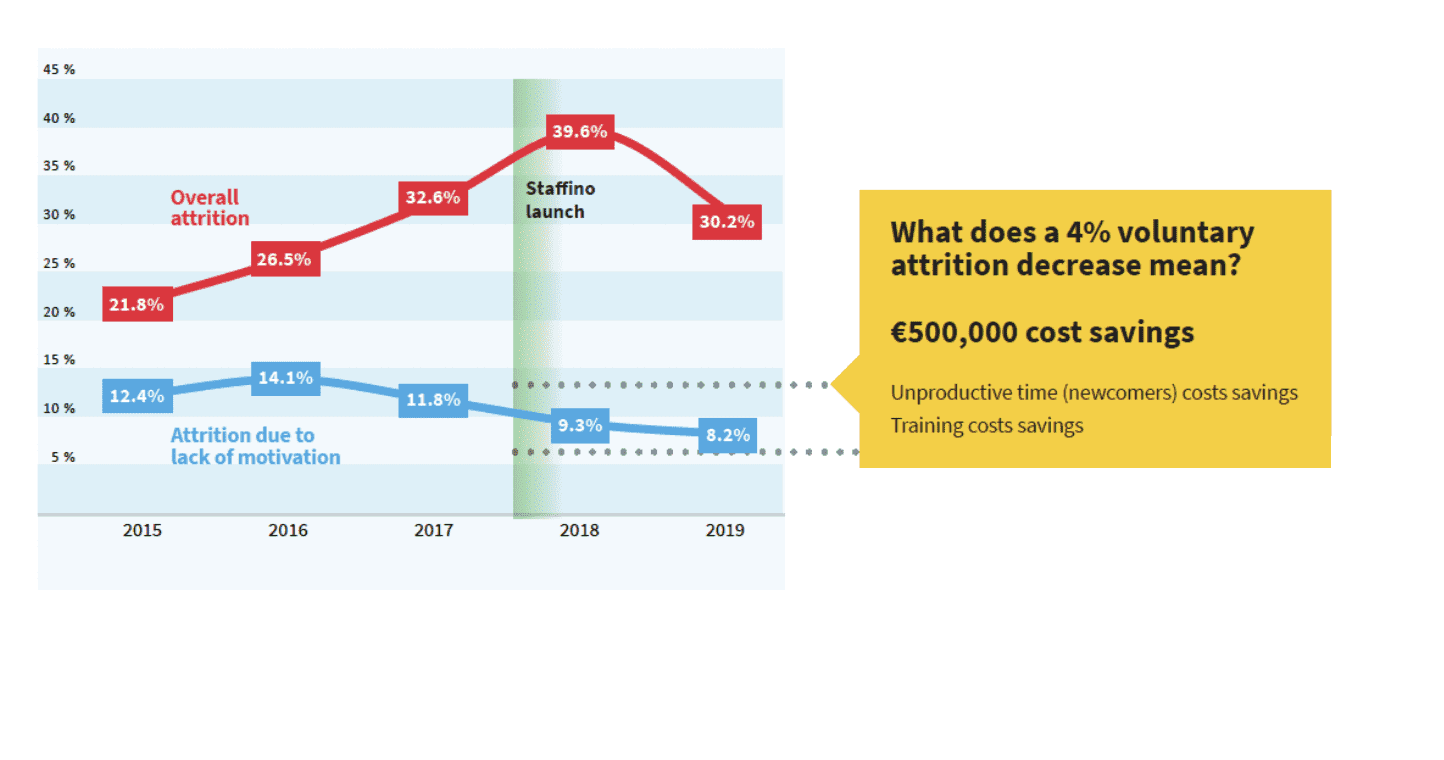
3. Employee Engagement
Recognition at work has a direct impact on employee engagement. Engaged employees are more committed to their work, exhibit higher levels of job satisfaction, and are more likely to contribute to the overall success of your organisation.
4. Positive Work Culture
A culture of recognition creates a positive work environment where employees feel appreciated and supported. This leads to increased collaboration, teamwork, and a sense of camaraderie among colleagues.
5. Increased Innovation and Creativity
Recognised employees are more likely to feel empowered and confident in sharing their ideas and suggestions. Employee recognition encourages innovation and creativity as employees feel valued and encouraged to contribute their unique perspectives and insights.
6. Improved Customer Satisfaction
When employees are recognised and motivated, they are more likely to provide excellent customer service, which is crucial for building customer loyalty. Recognised employees feel a sense of pride in their work and are more willing to go above and beyond to meet customer needs, resulting in increased customer satisfaction and loyalty.
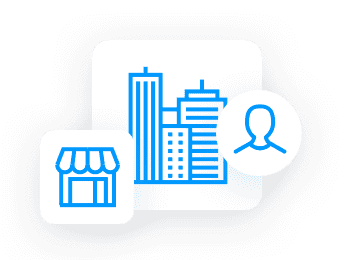
Retain Customers and Increase Profits!
Make sure your customer relationships don't slip away with Staffino's Retention Case Monitoring. This easy-to-use tool gives you the power to maximise customer retention and boost loyalty.
7. Revenue and Savings Increase
Eventually, staff recognition can lead to increased revenue and savings for your organisation. Recognised employees are more motivated and productive, leading to higher sales and improved customer service. Additionally, a positive work culture and higher employee retention rates reduce recruitment and training costs, resulting in savings for the company.
Recognition as a Top Motivator for Employees
Studies have consistently shown that staff recognition is one of the most powerful motivators for employees. It goes beyond monetary rewards and taps into the psychological needs of individuals.
“Genuine recognition satisfies the fundamental human desire for appreciation, validation, and a sense of belonging. When employees feel recognised, they are more likely to be engaged, committed, and motivated to achieve their goals.”
Jan Gabauer
Expert CX Consultant
Key Employee Recognition Statistics: The Power of Staff Recognition in Numbers
To better understand the significance of employee recognition, let’s explore some key statistics:
- 69% of employees say they would work harder if they felt their efforts were better recognised. (Source: Achievers)
- A study by the Society for Human Resource Management found that 77% of employees consider recognition in the workplace a key factor in job satisfaction. (Source: Society for Human Resource Management)
- According to a survey by TINYpulse, 79% of employees who quit their jobs cite lack of appreciation as one of the main reasons for leaving. (Source: TINYpulse)
- The Employee Job Satisfaction and Engagement report by the Society for Human Resource Management revealed that 93% of employees who feel valued at work are more motivated to do their best. (Source: Society for Human Resource Management)
- A study by the University of California, Riverside, found that employees who feel a sense of purpose at work are more likely to stay with the organisation and have higher levels of job satisfaction. (Source: University of California, Riverside)
- According to a survey by Glassdoor, 53% of employees believe that receiving recognition from their direct manager improves their relationship and trust with their employer. (Source: Glassdoor)

- A study by the American Psychological Association found that employees who feel valued by their employer are more likely to report higher levels of job satisfaction, positivity and motivation. (Source: American Psychological Association)
- 85% of employees are not engaged or actively disengaged at work. (Source: Gallup)
- Companies with engaged employees outperform those without by 202%. (Source: Dale Carnegie)
- Research conducted by the University of Warwick found that happy employees are 12% more productive than their unhappy counterparts. (Source: University of Warwick)
- The Harvard Business Review reported that companies with a highly engaged workforce experience a 19.2% growth in operating income over a 12-month period, compared to a 32.7% decline for companies with low employee engagement. (Source: Harvard Business Review)
- The Employee Engagement Benchmark Study by Temkin Group found that highly engaged employees are 5 times more likely to recommend their company to a friend or family member. (Source: Temkin Group)
These statistics highlight the impact of employee recognition and motivation on business success, underscoring the need for an effective employee recognition program.
What Are the Main Types of Employee Recognition?
There are various types of recognition for employees, including formal recognition programs, informal recognition, peer-to-peer recognition, and managerial recognition. Each type serves a unique purpose in acknowledging and appreciating employees’ contributions and fostering a sense of appreciation and teamwork within your organisation.
1. Formal Recognition Programs
These programs are structured and often involve predetermined criteria and processes. Examples include “Employee of the Month” awards, annual performance bonuses, or recognition ceremonies.
2. Informal Recognition
Informal recognition for employees occurs spontaneously and is not part of a structured program. It can be as simple as a thank-you note, a verbal compliment, or a small token of appreciation.
3. Peer-to-Peer Recognition
This type of employee to employee recognition at work involves employees acknowledging and appreciating the efforts of their colleagues. Peer recognition fosters a sense of teamwork and collaboration within the organisation.
4. Managerial Recognition
Managers play a crucial role in recognising and appreciating their team members. This can be done through one-on-one meetings, public praise, or recommending employees for promotions or development opportunities.
Monetary and Non-Monetary Employee Recognition: What Are Your Options?
In addition to the four main employee recognition types mentioned above, we can discuss two types of recognition from a financial perspective: monetary recognition and non-monetary recognition. While both can be effective in showing appreciation to employees, they have different impacts and benefits.
1. Monetary Recognition
Monetary recognition involves providing employees with financial rewards or incentives as a form of appreciation. This can include bonuses, salary increases, profit-sharing plans, or gift cards. Monetary recognition is often seen as a tangible and measurable way to acknowledge employees’ contributions. It can motivate employees to perform better and increase their loyalty to the organisation.
According to a survey conducted by Globoforce, 78% of employees said that being recognised monetarily motivates them to work harder. Additionally, a study by the Incentive Research Foundation found that 85% of companies have a financial recognition program in place.
Monetary employee rewards examples:
- Performance-based bonuses: Rewarding employees with bonuses based on their individual or team performance.
- Profit-sharing plans: Sharing a portion of the company’s profits with employees as a way to recognise their contributions to the organisation’s success.
- Salary increases: Monitor employee performance and provide salary raises to employees who have demonstrated exceptional results or achieved specific goals.
2. Non-Monetary Recognition
Non-monetary rewards and recognition in the workplace focus on acknowledging and appreciating employees without providing financial value. It can be equally effective in boosting employee morale and engagement. Non-monetary recognition often emphasises intrinsic motivators such as personal growth, work-life balance, and a positive work environment.
Research has shown that non-monetary recognition can have a significant impact on employee satisfaction and engagement. A survey by SHRM found that 70% of employees feel that recognition other than monetary rewards is more meaningful and satisfying.
Non-monetary employee rewards examples:
- Verbal praise and thank-you notes: Recognising employees through sincere verbal appreciation or written notes expressing gratitude for their contributions.
- Employee gamification badges: Create an employee gamification system where frontline employees and teams can earn virtual badges based on specific achievements or behaviours.

- Flexible work arrangements: Allowing employees to have flexible work hours or the option to work remotely as a way to recognise and accommodate their personal needs.
- Professional development opportunities: Providing employees with opportunities for training, mentorship, or attending conferences to support their career growth.
It is important to note that a combination of monetary and non-monetary recognition methods can be the most effective in creating a comprehensive and well-rounded employee recognition program. By understanding employees’ preferences and needs, you can tailor your recognition efforts to maximise their impact and create a positive work culture.
Verbal Recognition in the Workplace: What Do You Say to an Employee for Recognition?
When providing verbal recognition, be specific, sincere, and timely. Focus on the impact of their actions and how they align with the organisation’s goals. For example, instead of saying, “Good job,” say, “Your attention to detail and dedication to meeting deadlines on the recent project significantly contributed to its success. Thank you for your exceptional work.”
Verbal recognition is a powerful tool for acknowledging and appreciating employees. It is an essential aspect of employee appreciation and can be tailored to specific situations.
Here are a few verbal staff recognition ideas:
- When an employee goes above and beyond:
“John, I wanted to personally thank you for going the extra mile on the Smith account. Your innovative ideas and tireless efforts not only impressed the client but also helped us secure a long-term contract. Your dedication and commitment are truly commendable.”
2. When an employee demonstrates exceptional teamwork:
“Sara, I wanted to acknowledge your outstanding teamwork during the recent departmental project. Your ability to collaborate effectively, communicate clearly, and support your teammates was instrumental in achieving our collective goals. Your commitment to teamwork is truly inspiring.”
3. When an employee shows initiative:
“Mark, I wanted to recognise your initiative in identifying and implementing a more efficient process for our inventory management. Your proactive approach not only saved us time and resources but also improved overall productivity. Your initiative and problem-solving skills are highly valued.”
4. When an employee consistently exceeds expectations:
“Emily, I want to express my appreciation for your consistent high-quality work. Your attention to detail, thoroughness, and ability to consistently meet and exceed targets have not gone unnoticed. Your dedication to excellence sets a great example for the rest of the team.”
5. When an employee handles a challenging situation gracefully:
“Lisa, I want to commend you on how you handled yesterday’s difficult client situation. Your calm demeanour, professionalism, and ability to find a satisfactory resolution were truly impressive. Your exceptional customer service skills truly shine in these challenging moments.”
By acknowledging the impact of your employees’ specific actions and aligning it with the organisation’s goals, you can make your verbal recognition more meaningful and impactful for your employees.
How to Create Employee Recognition Culture in Your Workplace: A 5-Step Employee Recognition Program
Creating a culture of employee recognition is essential for fostering a positive and motivated workplace environment. By implementing a comprehensive employee recognition program, you can ensure that your employees feel valued and appreciated for their hard work and contributions. Follow these five steps to establish an effective employee recognition culture in your workplace:
1. Define Recognition Criteria
Clearly outline the behaviours, achievements, and contributions that warrant recognition. Ensure that the criteria align with the company’s values and goals.
2. Communicate Expectations
Communicate the recognition program to all employees, explaining how it works, what behaviours are valued, and how recognition will be given. Encourage participation and provide guidelines for peer-to-peer recognition.
3. Provide Training and Resources
Equip managers and employees with the necessary skills and tools to effectively recognise and appreciate others. Offer training on giving feedback, conducting recognition conversations, and utilising the recognition program.
4. Implement a Recognition Platform
Utilise an online employee experience software to streamline the recognition process. Such softwares or platforms provide user-friendly interfaces, making it easy for employees to give and receive recognition. Staffino’s EX platform offers various features for employee recognition and motivation, ensuring a seamless experience for both managers and employees.

Unlock Your Team's Full Potential with Staffino's EX Products
Our EX platform can help you attract and retain top talent, track employee performance, and improve engagement and productivity – so your team can reach their highest potential.
5. Celebrate and Reinforce
Celebrate recognised employees publicly, highlighting their achievements and the positive impact they have made. Regularly reinforce the importance of recognition through company-wide communications, newsletters, or team meetings.
Employee Recognition Examples from Successful Companies
How do you recognize an employee? Learn from successful companies and their workplace recognition programs to inspire and implement effective strategies in your own organisation! Here are some examples of how companies like Google, Salesforce, or Zappos have successfully recognised and appreciated their employees’ efforts:
1. Google
Google encourages peer-to-peer recognition through its “gThanks” program, where employees can send each other virtual thank-you notes and recognition badges.
2. Salesforce
Salesforce has a comprehensive recognition program called “Success Anywhere,” which includes a peer-to-peer recognition platform, manager-led recognition, and company-wide recognition events.
3. MALL.CZ
MALL.CZ, an online retailer, implemented a creative employee recognition strategy by incorporating gamification into their workplace. They used Staffino’s employee gamification module to establish a system where call centre agents could earn points and badges based on their customer experience performance and achievements. This innovative approach not only made work more enjoyable and engaging for employees but also fostered healthy competition among teams.
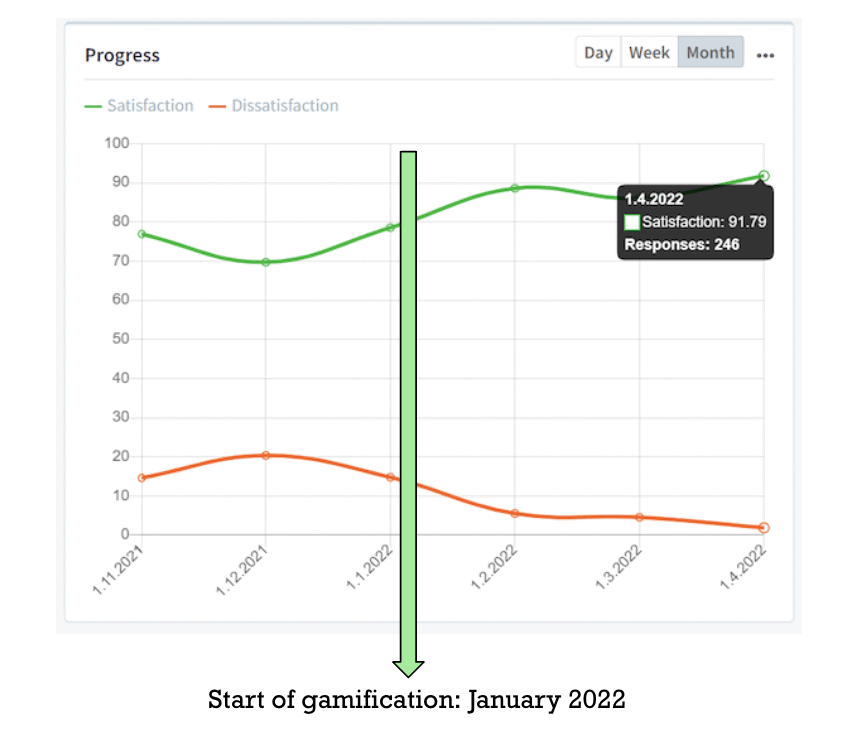
As a result, MALL.CZ experienced a notable 2-10% improvement in customer satisfaction in teams where gamification was effectively introduced and communicated. Read more in their employee recognition success story.
4. Zappos
Zappos has a unique recognition program called “The Hero Award.” Employees can nominate their colleagues for going above and beyond their regular duties, and winners receive a trophy and a monetary reward.
Recognising Employees through an Online Employee Experience Platform
Online employee experience platforms like Staffino provide a convenient and efficient way to recognise employees. Its user-friendly interface ensures that both managers and employees can easily access and engage with the recognition program, enhancing employee experience overall.
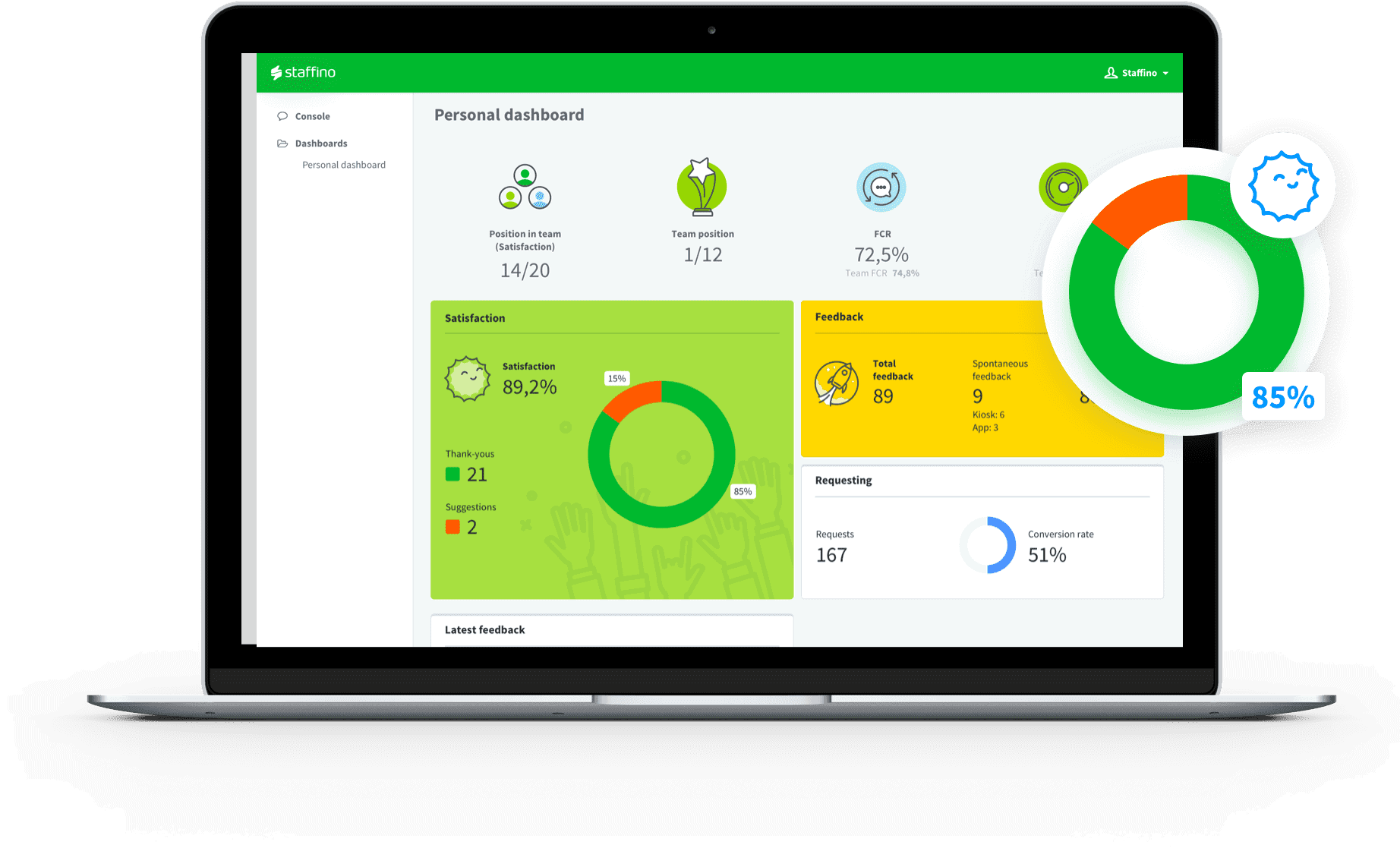
Staffino offers features such as manager-led recognition, real-time frontline employee recognition through positive customer feedback, virtual employee gamification rewards, and tools for tracking and managing recognition activities.
Let’s have a closer look at our employee recognition features:
1. Manager-Led Recognition
Staffino provides a platform for managers to easily recognise and appreciate their team members through the Internal Discussion feature. Managers can give personalised recognition, express gratitude, and acknowledge specific customer service achievements or contributions.
2. Real-Time Frontline Employee Recognition Through Positive Customer Feedback
Staffino’s closed-loop feedback tools allow organisations to capture and leverage positive customer feedback to recognise frontline employees in real-time. While negative feedback is only visible to managers, positive customer feedback can be shared publicly, motivating employees and boosting their confidence.
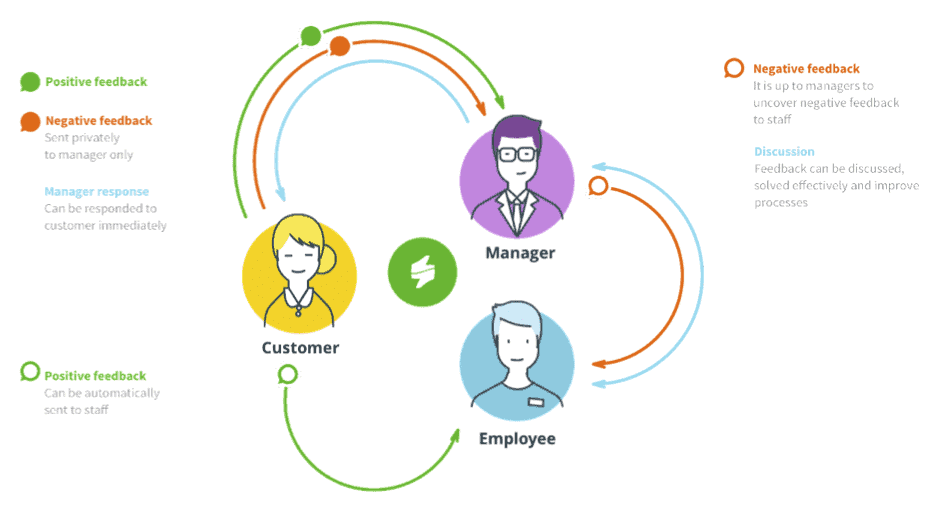
3. Virtual Employee Gamification Rewards
Staffino’s employee gamification module enables organisations to create a system where employees can earn virtual badges and rewards based on their customer satisfaction survey results and overall CX performance. This gamification element adds a fun and engaging aspect to recognition, encouraging healthy competition and motivating employees to excel.
4. Tools for Tracking and Managing Recognition Activities
Staffino provides tools for tracking and managing recognition activities within your organisation. This includes features like employee recognition survey creator and advanced analytics and reporting. These tools allow managers to monitor recognition trends, identify top performers, and track the impact of recognition efforts.
By utilising these features, we help our clients create a comprehensive employee recognition program that fosters a culture of appreciation, boosts employee morale, and enhances the overall employee experience.
Surveying Employee Recognition? These Are the Must-Have Employee Recognition Survey Questions
To measure the effectiveness of your organisation’s employee recognition efforts, it is important to conduct regular surveys. Below are some recommended employee recognition survey questions that will help you gather valuable feedback from your employees.
- Do you feel recognised for your contributions and achievements at work?
- How frequently do you receive recognition for your work?
- Have you received recognition from your peers or colleagues?
- Do you believe that recognition positively impacts your motivation and engagement?
- Are you aware of the recognition programs and initiatives in our organisation?
- How satisfied are you with the current recognition practices in our workplace?
- What suggestions do you have for improving our employee recognition efforts?

Additionally, if you are looking for an easy and efficient way to create and distribute employee recognition surveys, consider using our online platform. With Staffino, you can customise your survey questions to fit your organisation’s specific needs and ensure that each question is strategically posed to gather actionable feedback from your employees. The collected data then allows you to make informed decisions and improvements to your employee reward and recognition program.
Start Recognising Your Employees Today!
Employee recognition is a vital component of building a positive work culture, motivating employees, and driving organisational success. By implementing a comprehensive recognition program, you can create a culture of appreciation and foster employee engagement.
Leveraging online employee experience platforms like Staffino allows you to implement an effective employee rewards and recognition program, continuously improve your recognition initiatives by measuring the program’s success, and ensure the well-being and satisfaction of your workforce.
Remember, recognising employees is not just a nice gesture but a strategic investment in your organisation’s success.
Book a free demo with us to see how Staffino’s employee recognition tools work!

Get a First-Hand Experience Today!
Staffino is the perfect tool for creating engaging surveys, tracking performance, responding to customer feedback, and rewarding top employees. Get started today with our FREE demo!
FAQ
Employee recognition is how employers show appreciation for their employees’ efforts, achievements, or positive behaviours in the workplace.
You can say: “Thank you for your great work on [project]. Your contribution made a big difference.” Specific praise is more meaningful than generic compliments. Explore more recognition examples in our article.
You can recognize an employee with verbal praise, written messages, public shout-outs, financial bonuses, or non-monetary rewards. The key is being timely, specific, and sincere.
It means highlighting consistent performance, teamwork, reliability, innovation, or customer service, and showing appreciation for it in a meaningful way.
Recognition boosts employee motivation, engagement, and job satisfaction. It also encourages high performance and reduces turnover.
Monetary recognition includes bonuses, raises, or gift cards. Non-monetary recognition includes verbal praise, thank-you notes, awards, or development opportunities.
An employee recognition program is a structured way to regularly acknowledge employee achievements. It can include awards, peer recognition, incentives, or points-based systems.
A good recognition software allows you to give real-time, public or private feedback, track recognition data, and integrate with performance management tools. Staffino, for example, includes features like real-time recognition, gamification, and engagement tracking.







